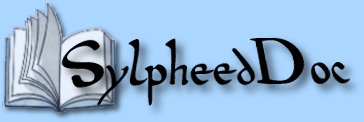
Home
Documentation
Contribution
16. Customization (General Setup)
Sylpheed offers you several ways to customize it's interface for your personal use.
16.1 General Setup Window
For making changes to Sylpheed's interface, you need to open the "common preferences" in the Configuration menu.
In here you will find a tabbed window that offers the following possibility to customize Sylpheed.
16.2 Description of Each Entry
In the third tab, "Compose", the following settings can be changed:
- Quoting the original text of a message
- Define the quoting character that is put in front of each line of text.
- Define the text that is placed in front of the quoted text
- An optional signature separator. This is a combination of characters that are placed in front of a signature text.
- Whether or not to insert the signature automatically
- Define if the account that recieved the message should automatically be used as the account from which the reply is sent. This also influences the signature to be selected.
- Set the position of the line where wrapping should occur.
- Select if the quoted text should be wrapped also.
- Indicate if e-mail text should be wrapped or not. If you choose not to select wrapping, then the lines you wrote will not be chopped up by carriage return/line feed characters.
Font.You can set the font that is used to display the messages.Translate header name.This options changes the behaviour of the different headers.Unread number.This toggles the display of the number of unread messages next to each mailbox.Display recipient.With this option you can tell Sylpheed to show the recipient in the summary view when you are the one who sent the message.Enable horizontal scrollbar.This option enables or disables showing the horizontal toolbar beneath the summary view. With the bar disabled, you cannot scroll to the right to see extremely long message subjects.Expand threads.If you disable this options and you have enabled the Threaded view through the Summary menu, threads are shown as collapsed lines with a '+' sign in front of them. Enable this option to show all the messages in a thread.Display unread with bold font.If you enable this checkbox, messages in the summary view that have not been read yet are shown in a bold font. Unchecking this option will of course show all messages in the default font.Date format.This option puts you in charge of the way the date of an e-mail message is shown. You can click the "..." button to open a new window. In there you see the codings that you can use to format the date. As you change the codings, an example is shown beneath the coding sequence of how your date will look.Set display item.This button allows you to select the specific columns that will be shown in the summary view.
Enable colorization.When you enable this option, you can define with what colors the message text and the quotings will be displayed.Display 2-byte alphabet and numeric with 1 character.This option is necessary for double-byte languages as Japanese and Chinese.Display header pane above message view.Enabled, this option shows the From, To and Subject headers from the selected e-mail in a separate area over the message view.Display short headers on message view.This option lets you select all the headers that will be shown in the message view window. There are options to enable all, no or selected headers.Line space.This option lets you select how many pixels of space Sylpheed has to show between the lines of text in the message view window.Leave space on head.Checking this box will make the start of new lines (unwrapped, where the writer has pressed the Enter/Return key) indent a few pixels. This can be useful to read larger e-mails.Scroll half page.When enabled, the text in the message view will only scroll half a page instead of a whole page when pressing the space bar.Smooth scroll.Enabling this box will make the text in the message view scroll in a smooth, sliding way. For the eye this can be pleasing, it is a personal preference.
- Opening the first unread message when you enter a folder.
- Automatically move focus to the inbox after new mail was received.
- Immediate execution of commands like delete, move or copy.
- Influence the way the "receive" dialog box behaves when new mail is retrieved (Always, When a window is active, Never).
- Double clicking an e-mail address can be used to put that address in a new e-mail.
- Confirming if you want to exit Sylpheed.
- Cleaning the trashbox when exiting Sylpheed.
- Have Sylpheed ask you to clean the trash before it is done.
- Warn you when exiting Sylpheed when there are still messages queued to be sent.
The web browser.Here you can enter the name of your favorite web browser (Netscape, Opera, Mozilla, Lynx etc.). Add the %s parameter to the command so Sylpheed knows it has to provide the text you clicked on as the URL that the browser has to visit.Printing.Here you can define the program that should be used to print. Default is lpr, and the %s is the name of the temporary file that Sylpheed creates for lpr to print.External editor.You can select an external editor to write your e-mails with, for example vi, emacs or gedit. Note that for text-based editors like vi, you need to define a terminal window, e.g.xterm -e vi %s. Otherwise there is no place that the editor will be able to show up. Here too, the %s parameter is the name of a temporary file that is created by Sylpheed.
Next Previous Contents